UX and UI—Do You Know the Difference?

It's likely that you've heard the terms UX and UI thrown around. Do you know what they mean?
Seattle is known for being a cutting-edge city—a vanguard for technology, coffee and culture (in pretty much every sense of the term). It's important to understand the lingo du jour, especially as a tech professional, a business owner or a project manager in this city—accurate communication shows you know your stuff, inspires confidence in your clients and facilitates efficiency. Regardless of what industry you work in, it's likely that you've heard the terms UX and UI thrown around, maybe while you were waiting for the bus or sitting in a coffee shop. But do you know exactly what they mean? Should you care?
UX: The User Experience
UX, from a design standpoint, essentially means always keeping the end user in mind. In the realm of web design, the interaction between the product and the end user is the obsession of the User Experience professional and involves the consideration of everything from site flow to ease of use. Because websites have become one of the main forms of communication between companies and their customers, UX considerations are crucial to keep in mind when you’re thinking about a site redesign or a brand-new design project.
Anything and everything that your visitors interact with can be designed in a way to create a positive user experience. From the moment a potential customer or client learns about you to the time they purchase your products or services (and beyond!), their experience should feel seamless and user friendly. Great UX not only provides customers with what they want, it gives them a smooth and consistent process while getting there.
The UX designer’s task is not simple. It requires comprehensive research on your customer’s needs while keeping your company’s goals and brand aesthetic in mind. It also involves wireframing, prototyping, testing, and troubleshooting, and following all of that up with tracking the success of the established goals.
Okay, so what is UI?
The difference is in the details, and that's where UI steps in. UI stands for User Interface and—in web design—refers to the beauty behind the experience.
Once the UX designer’s user-flow recommendations and wireframes have been set in place, the UI designer steps in to ensure the whole product is aesthetically pleasing. From color to typography, UI considerations revolve around creating a beautiful site that also reflects customer needs and UX goals.
To be sure, UI isn't just about making websites pretty. Well-implemented UI creates emotional connections between your visitor and your site. It also encourages user interactivity and engagement. UI reinforces your company’s branding by ensuring all elements—text, images, general layout and spacing—are cohesive with the brand story.
The job of a UI designer is also not easy—it involves analyzing customer data and finding creative and attractive ways to align the results of the analysis with company and brand identity goals. It also involves taking care of smaller details that may otherwise get overlooked, including the creation of working interactivity, animation and other stylistic features. UI designers work with developers to create a cohesive design that allows you to communicate with visitors not just through the text on the site, but through the look and feel of the design, as well.
UX/UI in the real world
Tying this all together with an example, let’s say you run a shoe-selling business. How would your site inspire your visitors to navigate from the homepage to the catalog—then inspire them further to add a pair of shoes (or several!) to their shopping cart? Implementing UX recommendations would be your first step toward ensuring that your end goal—getting the user to purchase a pair of shoes—is accomplished. UX creates clear and easy-to-navigate pathways throughout your site. But good UI is just as important—the more attractive and pleasurable the experience, the more likely the user will stick around long enough to find everything they need. This not only boosts sales but creates loyal customers and brand aficionados, as well.
Something important to note is that while our focus here has been web design, UX concepts can be used in pretty much any field; think of UX as a powerful “silent salesperson” that intuitively guides customers toward engaging with your business and performing desired actions. And while UI is more specific to the digital realm, paying attention to brand appeal is crucial for any company in any industry.
Designing for UX and UI isn't easy...
...but when it works, it creates a positive experience leading to loyal and repeat customers. Here at efelle creative, we’re crazy about UX and UI. Feel free to connect with us if you want to take your website and online marketing game to the next level.